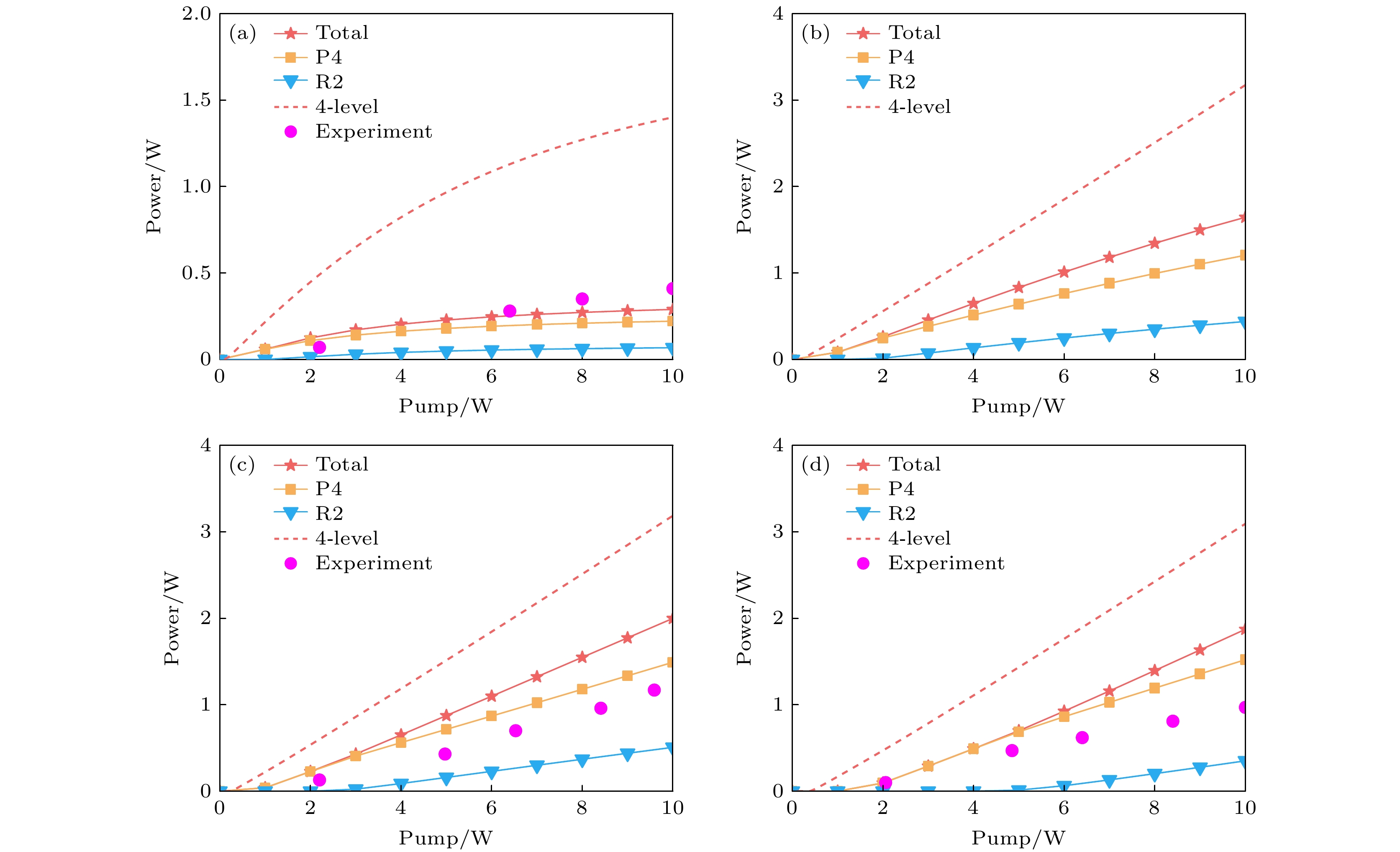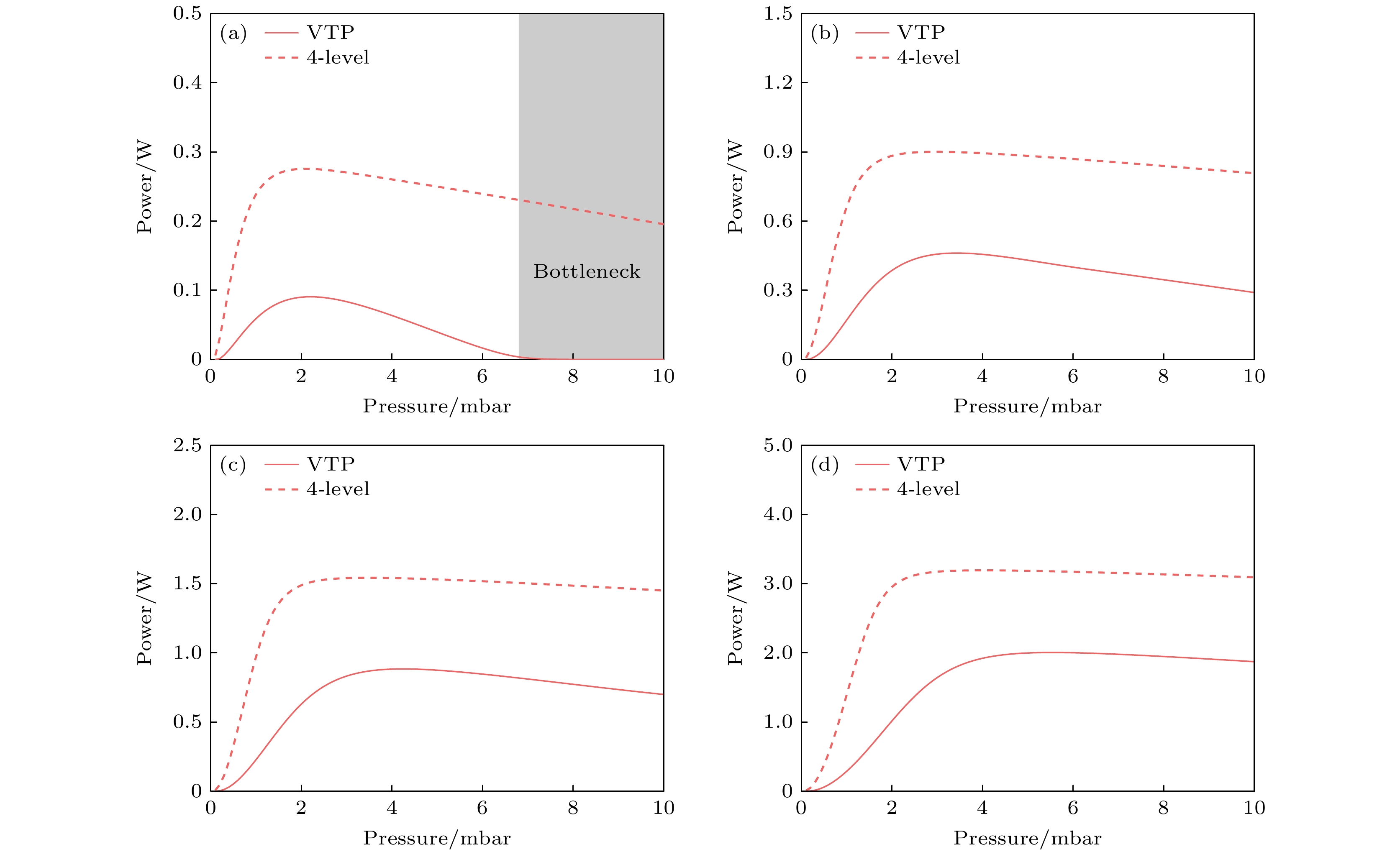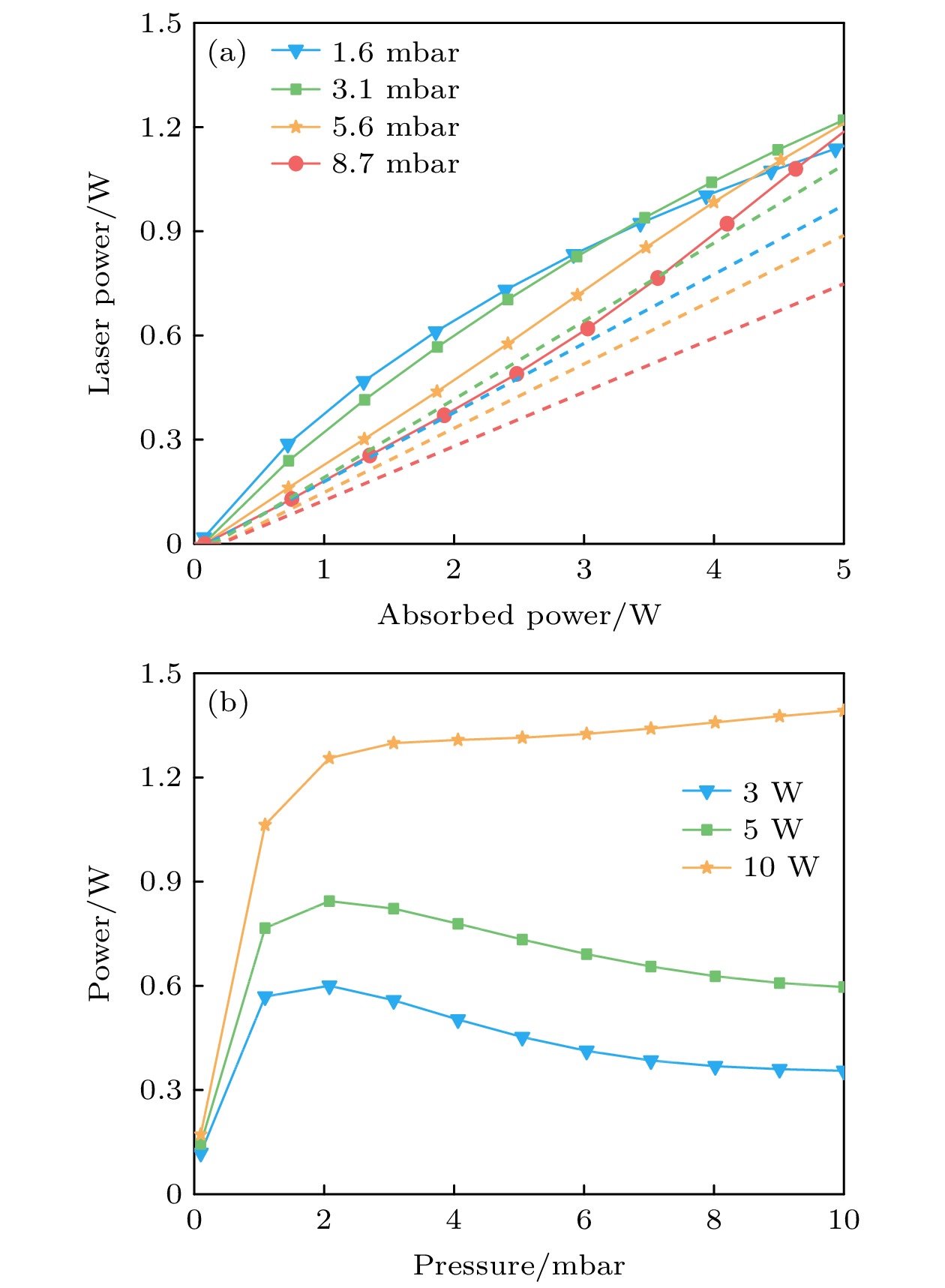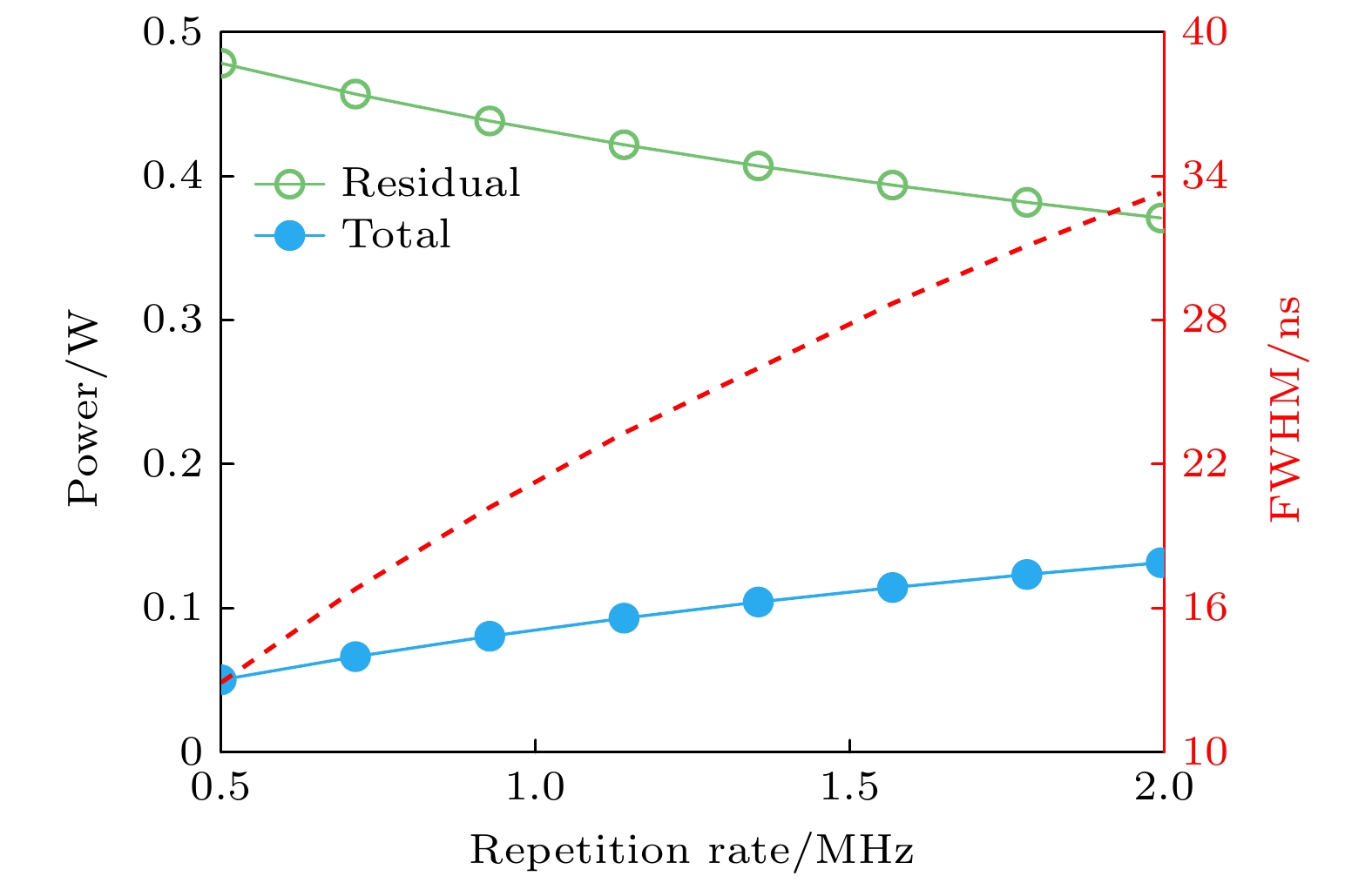-
空芯光纤气体激光器已逐渐发展为一种重要的中红外激光光源, 在实验上取得了良好进展, 但现有的基于传统速率方程模型的理论设计方法仍不完善. 本文提出了一种溴化氢(HBr)空芯光纤的振动热池建模方法, 该模型可充分考虑空芯光纤气体激光器内振转弛豫对腔内增益特性的影响, 计算显示激光斜效率、阈值和瓶颈效应与实验吻合良好. 此外, 基于该模型, 本文探讨了脉冲泵浦的光子泄漏现象, 通过引入泄漏因子, 得到了与实验结果接近的脉冲波形的弛豫振荡和激光斜率效率, 有效解决了脉冲泵浦模型中的泵浦溢出问题. 本研究提出的振动热池理论模型可适用于各类气体填充的空芯光纤气体激光器.The hollow-core fiber gas laser (HCFGL) has developed into a significant mid-infrared laser source, but the development of theoretical model still lags behind experimental progress. In this work, we propose a multi-level vibrational thermal pool (VTP) model of HBr-filled HCFs, which comprehensively considers the rovibrational relaxation effects on laser gain in reasonable approximations of transition coefficients, and studies the laser characteristics on multi-line lasing, bottleneck effect, line competition, etc. The VTP model shows more precise results of laser slope efficiency, and threshold than previous models while fitting the experimental data very well, and successfully predicts an output bottleneck at 1 W pump. The P-branch laser is relatively advantageous over the R-branch laser for its larger Einstein
$A$ coefficient and emission cross section, and the seed injection can intensify the line competition and reach the highest P4 power proportion of 80%. The VTP model reveals that the output of various pump lines has a pattern similar to the Boltzmann distribution, suggesting that the distribution of ground rotational levels limits the laser gain of pump lines. Moreover, we discuss the photon leakage in high-energy pulsed pumping conditions. With the introduction of the leaking coefficient, this model shows relaxation oscillations and laser slope efficiencies close to experimental values and greater than the results in the CW condition, and solves the overpump problem in pulsed pump simulation. Finally, we confirm that the photon leakage is intensified at high repetition rate and the leaking coefficient should relate to the pulse repetition rate. This work develops a comprehensive modeling method for MIR laser simulation and this model is also applicable to various gas-filled HCFGLs.-
Keywords:
- gas laser /
- hollow-core fiber /
- mid-infrared /
- rate equation
[1] Ycas G, Giorgetta F R, Baumann E, Coddington I, Herman D, Diddams S A, Newbury N R 2018 Nat. Photonics 12 202
 Google Scholar
Google Scholar
[2] Wang Z F, Zhou Z Y, Li Z X, Zhang N Q, Chen Y B 2016 Proceedings of the SPIE, Infrared, Millimeter-Wave, and Terahertz Technologies IV Beijing, China, October 12–14, 2016 p96
[3] Lei W, Jagadish C 2008 J. Appl. Phys. 104 091101
 Google Scholar
Google Scholar
[4] Guo B P, Wang Y, Peng C, Luo G, Le H Q 2003 Proceedings of the SPIE, Spectral Imaging: Instrumentation, Applications, and Analysis II March, 2003 p1
[5] Naithani S 2014 J. Laser Micro Nanoen. 9 147
 Google Scholar
Google Scholar
[6] Seddon A B 2011 Int. J. Appl. Glass Sci. 2 177
 Google Scholar
Google Scholar
[7] Austin D R, Kafka K R P, Lai Y H, Wang Z, Blaga C I, Chowdhury E A 2018 Opt. Lett. 43 3702
 Google Scholar
Google Scholar
[8] Wang Y Q, Fang J N, Zheng T T, Liang Y, Hao Q, Wu E, Yan M, Huang K, Zeng H P 2021 Laser Photonics Rev. 15 2100189
 Google Scholar
Google Scholar
[9] Kletecka C S, Campbell N, Jones C R, Nicholson J W, Rudolph W 2004 IEEE J. Quantum Electron. 40 1471
 Google Scholar
Google Scholar
[10] Ratanavis A, Campbell N, Nampoothiri A V V, Rudolph W 2009 IEEE J. Quantum Electron. 45 488
 Google Scholar
Google Scholar
[11] Koen W, Jacobs C, Bollig C, Strauss H J, Daniel Esser M J, Botha L R 2014 Opt. Lett. 39 3563
 Google Scholar
Google Scholar
[12] Fan G, Balčiūnas T, Kanai T, Flöry T, Andriukaitis G, Schmidt B E, Légaré F, Baltuška A 2016 Optica 3 1308
 Google Scholar
Google Scholar
[13] Peng X, Mielke M, Booth T 2011 Opt. Express 19 923
 Google Scholar
Google Scholar
[14] Michieletto M, Lyngsø J K, Jakobsen C, Lægsgaard J, Bang O, Alkeskjold T T 2016 Opt. Express 24 7103
 Google Scholar
Google Scholar
[15] Debord B, Amsanpally A, Chafer M, Baz A, Maurel M, Blondy J M, Hugonnot E, Scol F, Vincetti L, Gérôme F, Benabid F 2017 Optica 4 209
 Google Scholar
Google Scholar
[16] Carcreff J, Cheviré F, Galdo E, Lebullenger R, Gautier A, Adam J L, Coq D L, Brilland L, Chahal R, Renversez G, Troles J 2021 Opt. Mater. Express 11 198
 Google Scholar
Google Scholar
[17] Wang F, Lee J, Phillips D J, Holliday S G, Chua S L, Bravo-Abad J, Joannopoulos J D, Soljačić M, Johnson S G, Everitt H O 2018 Proc. Natl. Acad. Sci. 115 6614
 Google Scholar
Google Scholar
[18] Chevalier P, Amirzhan A, Wang F, Piccardo M, Johnson S G, Capasso F, Everitt H O 2019 Science 366 856
 Google Scholar
Google Scholar
[19] Chevalier P, Amirzhan A, Rowlette J, Stinson H T, Pushkarsky M, Day T, Capasso F, Everitt H O 2022 Appl. Phys. Lett. 120 081108
 Google Scholar
Google Scholar
[20] Lane R A, Madden T J 2018 Opt. Express 26 15693
 Google Scholar
Google Scholar
[21] Zhou Z Y, Huang W, Cui Y L, Li H, Pei W X, Wang M, Wang Z F 2023 Opt. Express 31 4739
 Google Scholar
Google Scholar
[22] Zhou Z Y, Cui Y L, Huang W, Li H, Wang M, Gao S F, Wang Y Y, Wang Z F 2023 J. Light. Technol. 41 333
 Google Scholar
Google Scholar
[23] Miller H C, Radzykewycz D T, Hager G 1994 IEEE J. Quantum Electron. 30 2395
 Google Scholar
Google Scholar
[24] Ratanavis A 2010 Ph. D. Dissertation (Albuquerque: The University of New Mexico
[25] Oka T 1974 Advances in Atomic, Molecular, and Optical Physics 9 127
 Google Scholar
Google Scholar
[26] Matteson W, De Lucia F 1983 IEEE J. Quantum Electron. 19 1284
 Google Scholar
Google Scholar
[27] Gordon I E, Rothman L S, Hargreaves R J, et al. 2022 J. Quant. Spectrosc. Radiat. Transf. 277 107949
 Google Scholar
Google Scholar
-
图 3 不同泵浦功率下光纤总输出与气压关系(实线代表VTP模型计算的总输出功率, 虚线代表4能级模型计算的总输出功率) (a) 1 W; (b) 3 W; (c) 5 W; (d) 10 W
Fig. 3. Output power of a 5 m long HCF varying with pump power: (a) 1 W; (b) 3 W; (c) 5 W; (d) 10 W. The solid line and dashed line represent the total output power obtained by VTP model and 4-level model, respectively.
图 4 (a) 注入1 mW P4小信号光与不注入时的光纤内部光强分布, 其中实线代表有P4小信号注入时的输出, 虚线代表ASE的输出; (b) 光纤总输出(蓝色实线)与P4光占比(红色虚线)随P4信号光的变化
Fig. 4. (a) Spatial distribution of laser power. The solid line represents the spatial power distribution with injected P4 signal, and the dashed line represents only ASE; (b) the total output power (blue line) and the proportion of P4 emission (red dashed line) varying with seed power.
图 5 不同泵浦谱线在10 W功率下的输出(x轴代表泵浦谱线, y轴代表输出功率, 柱状图代表相应的4 μm频点输出谱线, 红色曲线代表总输出功率) (a) R分支泵浦谱线输出; (b) P分支泵浦谱线输出
Fig. 5. Output power of different pump lines with 10 W pump power: (a) The output power of R-branch pump lines; (b) the output of P-branch pump lines. The x axis denotes the pump line, the y axis represents the output power, the bars represent the output lines in the 4 μm band, and the red line represent the total output power.
图 8 脉冲HCFGL的输出功率、半峰全宽与泵浦重频的关系, 其中绿色和蓝色实线代表残余泵浦光与总输出光的功率, 红色虚线代表总输出光的半峰全宽
Fig. 8. Output power and FWHM of HCFGL pulse varying with repetition rate. The green and blue line represent the residual pump power and total output laser power varying with repetition rate, respectively; the dashed red line represent the FWHM of output laser varying with repetition rate.
表 1 10 mbar下HBr气体分子R2泵浦谱线的常数(k, A, $\varOmega $)、光纤的损耗系数($\alpha $)
Table 1. Constants (k, A, $\varOmega $) of HBr molecule with R2 pumping at 10 mbar and absorption coefficients ($\alpha $) of HCF.
常数 取值 常数 取值 ${k_{10}}$/s–1 5×107 ${A_{{\text{pump}}}}$/s–1 0.14 ${k_{21}}$/s–1 1×107 ${A_{\text{P}}}$/s–1 8.56 ${k_{20}}$/s–1 2.5×106 ${A_{\text{R}}}$/s–1 5.91 ${k_{{\text{ro1}}}}$/s–1 7.5×107 $\varOmega $ 10–7 ${k_{{\text{ro2}}}}$/s–1 7.5×107 ${\alpha _{{\text{pump}}}}$/(dB·m–1) 0.53 ${k_{{\text{ro3}}}}$/s–1 7.5×106 ${\alpha _{\text{P}}}$/(dB·m–1) 0.3 ${k_{{\text{ro4}}}}$/s–1 7.5×107 ${\alpha _{\text{R}}}$/(dB·m–1) 0.3 -
[1] Ycas G, Giorgetta F R, Baumann E, Coddington I, Herman D, Diddams S A, Newbury N R 2018 Nat. Photonics 12 202
 Google Scholar
Google Scholar
[2] Wang Z F, Zhou Z Y, Li Z X, Zhang N Q, Chen Y B 2016 Proceedings of the SPIE, Infrared, Millimeter-Wave, and Terahertz Technologies IV Beijing, China, October 12–14, 2016 p96
[3] Lei W, Jagadish C 2008 J. Appl. Phys. 104 091101
 Google Scholar
Google Scholar
[4] Guo B P, Wang Y, Peng C, Luo G, Le H Q 2003 Proceedings of the SPIE, Spectral Imaging: Instrumentation, Applications, and Analysis II March, 2003 p1
[5] Naithani S 2014 J. Laser Micro Nanoen. 9 147
 Google Scholar
Google Scholar
[6] Seddon A B 2011 Int. J. Appl. Glass Sci. 2 177
 Google Scholar
Google Scholar
[7] Austin D R, Kafka K R P, Lai Y H, Wang Z, Blaga C I, Chowdhury E A 2018 Opt. Lett. 43 3702
 Google Scholar
Google Scholar
[8] Wang Y Q, Fang J N, Zheng T T, Liang Y, Hao Q, Wu E, Yan M, Huang K, Zeng H P 2021 Laser Photonics Rev. 15 2100189
 Google Scholar
Google Scholar
[9] Kletecka C S, Campbell N, Jones C R, Nicholson J W, Rudolph W 2004 IEEE J. Quantum Electron. 40 1471
 Google Scholar
Google Scholar
[10] Ratanavis A, Campbell N, Nampoothiri A V V, Rudolph W 2009 IEEE J. Quantum Electron. 45 488
 Google Scholar
Google Scholar
[11] Koen W, Jacobs C, Bollig C, Strauss H J, Daniel Esser M J, Botha L R 2014 Opt. Lett. 39 3563
 Google Scholar
Google Scholar
[12] Fan G, Balčiūnas T, Kanai T, Flöry T, Andriukaitis G, Schmidt B E, Légaré F, Baltuška A 2016 Optica 3 1308
 Google Scholar
Google Scholar
[13] Peng X, Mielke M, Booth T 2011 Opt. Express 19 923
 Google Scholar
Google Scholar
[14] Michieletto M, Lyngsø J K, Jakobsen C, Lægsgaard J, Bang O, Alkeskjold T T 2016 Opt. Express 24 7103
 Google Scholar
Google Scholar
[15] Debord B, Amsanpally A, Chafer M, Baz A, Maurel M, Blondy J M, Hugonnot E, Scol F, Vincetti L, Gérôme F, Benabid F 2017 Optica 4 209
 Google Scholar
Google Scholar
[16] Carcreff J, Cheviré F, Galdo E, Lebullenger R, Gautier A, Adam J L, Coq D L, Brilland L, Chahal R, Renversez G, Troles J 2021 Opt. Mater. Express 11 198
 Google Scholar
Google Scholar
[17] Wang F, Lee J, Phillips D J, Holliday S G, Chua S L, Bravo-Abad J, Joannopoulos J D, Soljačić M, Johnson S G, Everitt H O 2018 Proc. Natl. Acad. Sci. 115 6614
 Google Scholar
Google Scholar
[18] Chevalier P, Amirzhan A, Wang F, Piccardo M, Johnson S G, Capasso F, Everitt H O 2019 Science 366 856
 Google Scholar
Google Scholar
[19] Chevalier P, Amirzhan A, Rowlette J, Stinson H T, Pushkarsky M, Day T, Capasso F, Everitt H O 2022 Appl. Phys. Lett. 120 081108
 Google Scholar
Google Scholar
[20] Lane R A, Madden T J 2018 Opt. Express 26 15693
 Google Scholar
Google Scholar
[21] Zhou Z Y, Huang W, Cui Y L, Li H, Pei W X, Wang M, Wang Z F 2023 Opt. Express 31 4739
 Google Scholar
Google Scholar
[22] Zhou Z Y, Cui Y L, Huang W, Li H, Wang M, Gao S F, Wang Y Y, Wang Z F 2023 J. Light. Technol. 41 333
 Google Scholar
Google Scholar
[23] Miller H C, Radzykewycz D T, Hager G 1994 IEEE J. Quantum Electron. 30 2395
 Google Scholar
Google Scholar
[24] Ratanavis A 2010 Ph. D. Dissertation (Albuquerque: The University of New Mexico
[25] Oka T 1974 Advances in Atomic, Molecular, and Optical Physics 9 127
 Google Scholar
Google Scholar
[26] Matteson W, De Lucia F 1983 IEEE J. Quantum Electron. 19 1284
 Google Scholar
Google Scholar
[27] Gordon I E, Rothman L S, Hargreaves R J, et al. 2022 J. Quant. Spectrosc. Radiat. Transf. 277 107949
 Google Scholar
Google Scholar
计量
- 文章访问数: 3804
- PDF下载量: 55
- 被引次数: 0















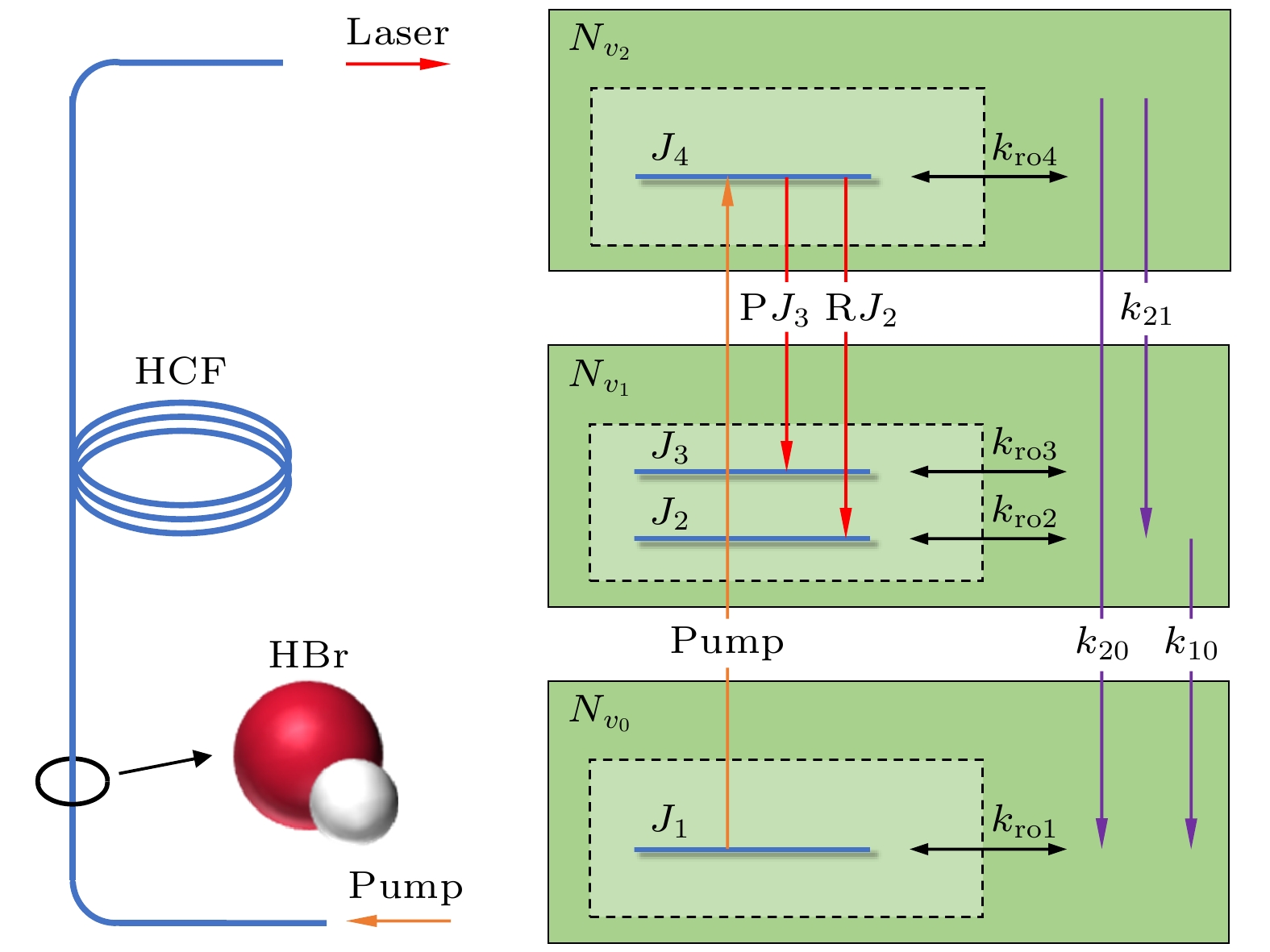
 下载:
下载:
